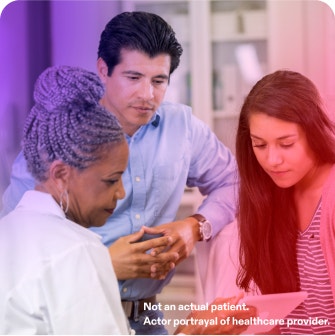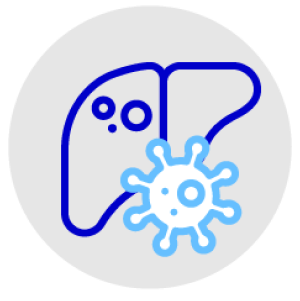

SAFETY
Safety information
On this page:
WARNING:
SIGNIFICANT DRUG INTERACTIONS WITH PAXLOVID

PAXLOVID includes ritonavir,
a strong CYP3A inhibitor, which may lead to greater exposure of certain concomitant medications, resulting in potentially severe, life-threatening, or fatal events

Prior to prescribing PAXLOVID:
- Review all medications taken by the patient to assess for potential drug-drug interactions with a strong CYP3A inhibitor like PAXLOVID and
- Determine if concomitant medications require a dose adjustment, interruption, and/or additional monitoring

Consider the benefit of PAXLOVID treatment in reducing hospitalization and death, and whether the risk of potential drug-drug interactions for an individual patient can be appropriately managed

Contraindications
PAXLOVID is contraindicated in patients with a history of clinically significant hypersensitivity reactions [eg, toxic epidermal necrolysis (TEN) or Stevens–Johnson syndrome] to its active ingredients (nirmatrelvir or ritonavir) or any other components of the product. If signs and symptoms of a clinically significant hypersensitivity reaction or anaphylaxis occur, immediately discontinue PAXLOVID and initiate appropriate medications and/or supportive care.
PAXLOVID is contraindicated with drugs that are primarily metabolized by CYP3A and for which elevated concentrations are associated with serious and/or life-threatening reactions and drugs that are strong CYP3A inducers where significantly reduced nirmatrelvir or ritonavir plasma concentrations may be associated with the potential for loss of virologic response and possible resistance. There are certain other drugs for which concomitant use with PAXLOVID should be avoided and/or dose adjustment, interruption, or therapeutic monitoring is recommended. Drugs listed here are a guide and not considered a comprehensive list of all drugs that may be contraindicated with PAXLOVID. The healthcare provider should consult other appropriate resources such as the prescribing information for the interacting drug for comprehensive information on dosing or monitoring with concomitant use of a strong CYP3A inhibitor like PAXLOVID. For contraindicated drug interactions, please see the DRUG INTERACTIONS PAGE or the FACT SHEET FOR HEALTHCARE PROVIDERS.

Warnings and precautions
Risk of serious adverse reactions due to drug interactions
Initiation of PAXLOVID, which contains ritonavir, a strong CYP3A inhibitor, in patients receiving medications metabolized by CYP3A or initiation of medications metabolized by CYP3A in patients already receiving PAXLOVID may increase plasma concentrations of medications metabolized by CYP3A. Medications that induce CYP3A may decrease concentrations of PAXLOVID.



These interactions may lead to:
- Clinically significant adverse reactions, potentially leading to severe, life-threatening, or fatal events from greater exposures of concomitant medications
- Loss of therapeutic effect of PAXLOVID and possible development of resistance
Severe, life-threatening, and/or fatal adverse reactions due to drug interactions have been reported in patients treated with PAXLOVID. The most commonly reported concomitant medications resulting in serious adverse reactions were calcineurin inhibitors (eg, tacrolimus, cyclosporine), followed by calcium channel blockers.
Hepatotoxicity

Risk of HIV-1 resistance development
Because nirmatrelvir is coadministered with ritonavir, there may be a risk of HIV-1 developing resistance to HIV protease inhibitors in individuals with uncontrolled or undiagnosed HIV-1 infection.

Adverse reactions
Clinical trials experience
Because clinical trials are conducted under widely varying conditions, adverse reaction rates observed in the clinical trials of a drug cannot be directly compared to rates in the clinical trials of another drug and may not reflect the rates observed in practice.
The safety of PAXLOVID is based on 2 phase 2/3 randomized, placebo-controlled trials in symptomatic adult participants ≥18 years of age with a laboratory-confirmed diagnosis of SARS-CoV-2 infection. Participants in both studies received PAXLOVID (nirmatrelvir 300 mg/ritonavir 100 mg) or placebo every 12 hours for 5 days for the treatment of mild-to-moderate COVID-19 within 5 days of symptom onset.
- EPIC-HR enrolled participants who were at high risk for progression to severe disease
- EPIC-SR enrolled participants who were at standard risk for progression to severe disease (previously unvaccinated subjects at standard risk or fully vaccinated subjects with at least 1 risk factor for progression to severe disease)
Adverse reactions were those reported while participants were on study medication and through 28 days after the last dose of study medication.
In EPIC-HR, 1038 participants received PAXLOVID and 1053 participants received placebo.
The most common adverse reactions (≥1% incidence in the PAXLOVID group and occurring at a greater frequency than in the placebo group)
The proportions of participants who discontinued treatment due to an adverse event:

Among vaccinated or unvaccinated participants at standard risk or fully vaccinated participants with at least 1 risk factor for progression to severe disease in EPIC-SR, 540 participants received PAXLOVID and 528 participants received placebo. The adverse reactions observed were consistent with those observed in EPIC-HR.
Post-authorization experience
The following adverse reactions have been identified during post-authorization use of PAXLOVID:
- Immune system disorders: anaphylaxis, hypersensitivity reactions
- Skin and subcutaneous tissue disorders: toxic epidermal necrolysis, Stevens-Johnson syndrome
- Nervous system disorders: headache
- Vascular disorders: hypertension
- Gastrointestinal disorders: abdominal pain, nausea, vomiting
- General disorders and administration site conditions: malaise

Clinical pharmacology
Viral RNA rebound and treatment-emergent substitutions
EPIC-HR and EPIC-SR were not designed to evaluate COVID-19 rebound; exploratory analyses were conducted to assess the relationship between PAXLOVID use and rebound in viral RNA shedding levels.
Posttreatment increases in SARS-CoV-2 RNA shedding levels in nasopharyngeal samples were observed on day 10 and/or day 14 in a subset of PAXLOVID and placebo recipients in EPIC-HR and EPIC-SR, irrespective of COVID-19 symptoms. The frequency of detection of posttreatment viral RNA rebound varied according to analysis parameters, but was generally similar among PAXLOVID and placebo recipients. A similar or smaller percentage of placebo recipients compared to PAXLOVID recipients had nasopharyngeal viral RNA results < lower limit of quantitation (LLOQ) at all study timepoints in both the treatment and posttreatment periods.
In EPIC-HR, of 59 PAXLOVID-treated participants identified with posttreatment viral RNA rebound and with available viral sequence data, treatment-emergent substitutions in Mpro potentially reducing nirmatrelvir activity were detected in 2 (3%) participants, including E166V in 1 participant and T304I in 1 participant. Both subjects had viral RNA shedding levels <LLOQ by day 14.
Posttreatment viral RNA rebound was not associated with the primary clinical outcome of COVID-19–related hospitalization or death from any cause through day 28 following the single 5-day course of PAXLOVID treatment. The clinical relevance of posttreatment increases in viral RNA following PAXLOVID or placebo treatment is unknown.
COVID-19=coronavirus disease 2019; CYP3A=cytochrome P450 3A; HIV=human immunodeficiency virus; Mpro=main protease; RNA=ribonucleic acid; SARS-CoV-2=severe acute respiratory syndrome coronavirus 2.
Reference:
Fact Sheet for Healthcare Providers: Emergency Use Authorization for PAXLOVID®. Pfizer Inc.; 2025.